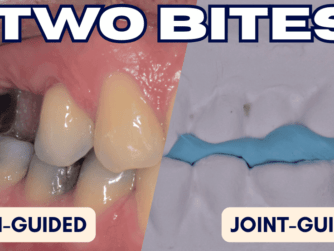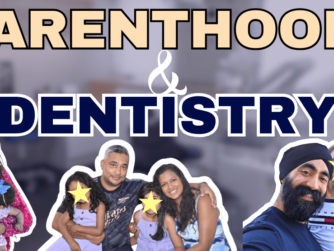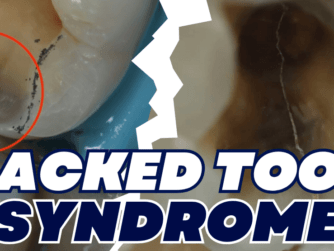Podcast: Play in new window | Download (Duration: 47:51 — 68.2MB)
When you present your patients with the ideal options, but they end up choosing ‘patch-up’ Dentistry…this is a real world problem, and we will tackle it in a comprehensive way in this Group Function!
Thank you Anonymous Dentist on Instagram for sending in this BRILLIANT question:
Hey jaz! I’ve been listening to your podcast and I’m a huge fan!
Anonymous Dentist in the UK, Instagram
I especially enjoyed the Chris Orr one and the communication one.
I just wondered if I could have some advice please..
I’m working across two practices at the moment, 1 fully private and 1 mixed practice.
At the mixed practice, often patients with broken teeth don’t want to pay for crowns/onlays even though I spell out the benefits, often they will go for a replacement amalgam (which I hate doing) or a large private composite (again risk of debond due to the size)
What would you recommend? If a patient doesn’t want to pay for a crown /onlay but you’ve spelt it all out then I’m not sure what else I can do?
Thanks in advance! X
You all know what happens when you get Zak Kara to give a quick answer….there is not such thing! Dr Zak Kara goes way beyond the call of duty and delivers us solutions in his signature comprehensive fashion!
We tried to steer away from the NHS vs Private Dentistry debate too much – but definitely your environment and the values of your patients plays a huge role.
Thank you so much for sending this question in – if anyone has a question they want to submit, do contact me via the website or send your question via DM on Protrusive Dental Instagram.
If you found this valuable, share it with your associates and principals.
If you liked this, you will also like Zak’s gems on Communication in Episode 10!
Here are some comprehensive notes/episode summary was written by fellow Protruserati, Taha Adamji – Thank you, Taha!:
PDP GF002 – Communication with Zak Kara – patients always choosing the inferior option
ROLE PLAY
Building rapport as you’re coming up/welcoming them in
E.g. How was your journey in today?/How’s your day going today?
Feel free to put your things over there and take a seat – give them clear direction when they come in about what to do
What can I do for you?
- My molar broke – yes I heard, (Receptionist name) told me you’re having a bit of trouble with a tooth on the UL
- I’ve had a look through your notes/X-rays/photos etc – from your previous visits – this shows you are well prepared to help them
Sorry to hear that/ that can happen sometimes (empathy)
- Is this the first time this has happened to you or has it happened before? (History)
- Am I right that it doesn’t/does it hurt right now?
- Is it rough to your tongue/uncomfortable?
Patient mentioned the clinic/gave praise
- Thank you/that’s kind of you to say, I’m reassured by that/what do you already know about us?/it’s your first time seeing me /you saw (x) dentist previously is that right? – all shows you have taken the time time to read their notes/are interested in them and their past experiences
Patient apologised for not coming
- That’s no problem/Don’t apologise/there’s no need to apologise. What we do here is always blame free/judgement free dentistry
Let’s see how we can help you with this problem tooth today:
- Because this is a “get you of of trouble type of appointment”/urgent/emergency appt, the aim for today is to focus on that one tooth
- I’m not going to do a full health check/exam today if that’s okay, I’m going to focus on this main problem for you
- But let’s also check there’s nothing else urgent going on and then we’ll see if we can get this problem solved for you by the end of the visit
- What did you hope or expect was going to happen today? (Check expectations)
“I was hoping it could be patched up and then I would be on my way”
- that’s definitely something we could do for you to make it smoother/perhaps take away that sharp edge so that it’s more comfortable
- Does that sound okay to you?
“How long is that going to last me”
- Well why don’t we take a bit of a look at it/I’ll put my magnification on/mask up (emphasises you’re going to look at it carefully, in detail)
- don’t over promise too early – investigate it first, don’t make any assumptions about treatment options yet
- Often when a tooth breaks there’s a reason behind it / did you have an idea on why that might have happened in your tooth’s case?
“ I shouldn’t have had that chocolate”
Patient/dentist may tend to focus in on the tooth in isolation only – but we need to look at the mouth and the patients as a whole
- what is the patients goal here?
- any pain to resolve?
- Roughness/sharp edges – we are going to solve this today
- Long term goal/expectations?
Examination
Let’s put the chair back and have a look your tooth but first:
- I’m going to ask you to bite together, let me have a gentle feel of your glands under your chin
- Let me have a gentle feel of your jaw joint – so open nice and big for me
- Check the soft tissues etc
Demonstrates to the patient that you are checking not just the tooth but the whole mouth
Keep signposting exactly what you’re doing as your doing it – try not to have a silent examination – describe everything you’re doing as you do it
- the word gentle – implies not going to be rough, taking your time, nothing sudden
Describe in lehman terms for the patients benefit and for the nurses – any technical terms means write this down:
- I can see the very back tooth – is broken down to a large extent/a quarter of the tooth missing/the inner wall of the tooth is missing/the existing silver filling is still in place
Checking if TTP/palpating:
- Lets have a gentle feel of the tooth/ I’m going to gently tap/press on a few teeth if that’s okay/and number them 8,7,6,5
- “If that’s okay?”
- Press and see if any response – don’t just start whacking teeth with the mirror handle unexpectedly
Co-diagnosing with the patient:
- How about we translate this to English for you in just a second
- I want to keep you in the loop
- I know dentists are weird, we talk in technical terminology because we’re trying to sound clever
Checking with a perio probe:
- I want to gently feel around the tooth to check where the edge of the broken section of the tooth is
- To check if it broken below or above the gum line – and that makes a difference – we’ll come back to that for you
I want to take an X-ray of this tooth (nurses name) if that’s okay – so that I can see the root end of the tooth (knows it’s a PA)
- Takes X-ray
- We’re going to get that developed then we can see it on the screen
- In the mean time let’s take a photograph/intra oral camera/scan of the tooth to have a closer look and we can show you
Tap on the shoulder/Why don’t you have a sit up I’ll bring the chair up, feel free to take the glasses off, we’ll take a look at the x-ray and photos together?
- Would you like me to give you a bit of an overview of what’s going on?
Need to relate everything that is happening to the context of the patients life
- Demographic
- Their expectations
- What has been done before/what is normal for them – constant patch ups
- Cost/budget/practice plan fees
- Time/effort required
- The patients inner monologue/beliefs and values about their teeth – normal for them to lose teeth?
- Very difficult to change a patients mindset, takes a long time
Instil your values, of comprehensive care to your patient base through your content- blogs/Instagram/newsletters?
- patient base becomes self selecting
- if they want things patched up that’s completely acceptable too – they need to understand the implications of this however
Shows photograph of broken tooth
- “Errr Is that what my tooth looks like?”
- Can you imagine having a job where we have to look at this all day long? (Jokes lighten the tone)
- Can I give you summary of what I can see here?
So there’s 3 things we’re looking at here:
- Bone support
- Is the tooth well embedded in its foundations – roots of teeth and bone is like a tent peg in the ground/molar has 3 roots like your fingers in a bowling ball – really well embedded
- Does that make sense so far? Chunking and checking – give bits of information then check they understand it – so that’s the first thing
2. Structural stability
- The second thing – and the main reason you’ve come to see us today – we need to check that the tooth is mechanically sound
- Did you know a silver filling is not glued inside the tooth? It sits inside the tooth/the channel in the middle keeps the filling in place- like a pear shape – it’s deeper at the bottom than at the top
- Can you see how thin this part of the tooth is – it’s so fragile – I can imagine that is what was going on before it broke on the other side
- You know when a bridge falls down over a river – can you imagine it wasn’t the last car that drove over it that caused it to collapse – it was actually the fact that it probably going wrong for some time – does that make sense?
- What I’m trying to say is this tooth hasn’t instantly broken from a bit of chocolate – it was probably heading that way for a period of time
3. Biological seal
- When you have a filling inside of a tooth it needs to be sealed all the way around the edges because it’s a bacteria seal
- if bacteria manage get in and around your filling they can get underneath (I know this sounds a bit horrible) but that means the filling is leaking
- And that leakage around the edges can soften the foundations
- a lot of people come to see us thinking they have broken their tooth on a olive stone or a chocolate – but probably the tooth and the filling has been deteriorating over time because the filling is sitting on soft foundations
Patients value the explanation – because it matters in terms of what our options are next – can I show you why?
Can I show you a picture of somebody else who has been in a similar situation to you?
- Get out iPad with photos to show example
- This is Jane who came to see me (always put context with somebody’s name on it – that matters because they can visualise that this was a real persons tooth)
- Here is Jane’s tooth with a silver filling in it – luckily we preempted the breakage in this tooth – can you see that tiny wall of the tooth is starting to crack – we realised that this was going to break at some point so what we did was we removed the filling – swipe on the iPad to show the filling removed
- Can you see the dark brown foundations underneath there – this is deteriorating underneath
- Can you see that the wall of this tooth here is very thin? – it’s so fragile that if i’d left that in place, Jane would be coming back a few weeks or months later and even this part of the tooth might have broken off as well
- So here is what we did – we have filled in the missing tooth structure – we shaped down the tooth to a degree and put a strong cap over the top and this binds the whole thing together
- Like having a helmet on top of a head/jubilee clip
- It prevents flexing of the thin part of the tooth from from breaking
Can I ask you how much of a risk taker are you?
- The reason I ask you that is because today what I’d recommend is that I’m going to seal this section for you because we want to reduce the chance that surface of the tooth become sensitive at some point – it will also make it a bit smoother so your tongue won’t keep going there/feels a bit more comfortable for you
- The reason I ask you about risk taking is because it depends how quickly we want to proactively do something for your tooth – the longer we leave it the higher the chance that the other thin wall of the tooth is going to break away
If you don’t want to do a larger MODP amalgam or composite – maybe don’t offer it? or present it in such a way that it is not a good option?
- If we want to do something that will help keep your tooth in your mouth for a long period of time i.e. hopefully years, decades and if your lucky – the rest of your life
- then we need to do something proactive and strong to protect this thin wall
- My worry with this tooth (patient name) is that if the remaining part of your tooth breaks off and you come to see me there may be no tooth left to rebuild – so let me ask you well how would that make you feel? (some patients would not be that bothered at this stage – just take it out – but others may really want to prevent this situation)
If the patient is still choosing the ‘subpar’ big filling option – then you could play devil’s advocate and ask them – how long would you expect it to last for? Because they need to understand that this will probably not last very long
- If they are chipping bits of tooth off everywhere why might this be?
- NB: Can place a direct composite core overlay – as an interim measure – allows you time to assess pulpal health/periapical issues
Always present the best option first
- “If it was my tooth…” ?
- for all the reasons I’ve explained, with the photos etc the tooth would really benefit from protecting these thin walls by putting a cap/onlay on there as you will get the longest lasting result – this will cost £x and I think it will last you a long time
- You have the option of going for a big filling BUT I don’t think that it’s going to last you as long, and it will cost £x
- Talk about the better option for longer – not manipulative
“What would you do?”
Just tell them what you would actually do (don’t dodge the question) honesty is the best policy don’t try to force them to make the decision themselves and avoid any responsibility because that may just harm your rapport with the patient (seems like you don’t care?)
You need to have the context of the patient when knowing what the best option for them is going to be
- teeth are not in isolation – they in people’s mouths
- What are their life circumstances and approach to dealing with a problem in order to find the best solution for them
- Is the patient okay with continually patching things up or do they value having something that is going to last a long time
- do they know how long the patch up will last for and the cost for each time to have it fixed?
- Would they rather pay more to have a longer lasting option?
- Or are they okay with losing the tooth if it breaks down further?
- maybe its better/in the patients best interests to not offer the subpar option?
There isn’t just the initial financial implication – but also to do with the number of repeats –
- They may be back again soon paying the same amount again to have it fixed
- Unlike building work – if everything goes horribly wrong – you can knock it down and start again
- but with teeth once it’s gone – the bit that mother nature has given you – is gone







